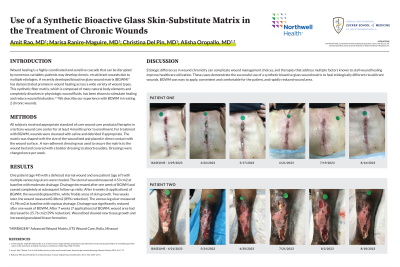Case Series/Study
(CS-109) Use of a Synthetic Bioactive Glass Skin-Substitute Matrix in the Treatment of Chronic Wounds

Wound healing is a highly coordinated and sensitive cascade that can be disrupted by numerous variables; patients may develop chronic, recalcitrant wounds due to multiple etiologies. A recently developed bioactive glass wound matrix (BGWM)* has demonstrated promise in wound healing across a wide variety of wound types. This synthetic fiber matrix, which is composed of many natural body elements and completely dissolves in physiologic wound fluids, has been shown to stimulate healing and reduce wound bioburden.1-3 We describe our experience with BGWM in treating 2 chronic wounds.
Methods:
All subjects received appropriate standard of care wound care products/therapies in a tertiary wound care center for at least 4 months prior to enrollment. For treatment with BGWM, wounds were cleansed with saline and debrided if appropriate. The matrix was shaped to fit the size of the wound bed and placed in direct contact with the wound surface. A non-adherent dressing was used to secure the matrix to the wound bed and covered with a bolster dressing to absorb exudate. Dressings were changed once per week.
Results:
One patient (age 49) with a dehisced sternal wound and one patient (age 67) with multiple venous leg ulcers were treated. The sternal wound measured 4.53 cm2 at baseline with moderate drainage. Drainage decreased after one week of BGWM and ceased completely at subsequent follow-up visits. After 6 weeks (6 applications) of BGWM, the wound displayed thin, white friable areas of skin growth. Two weeks later, the wound measured 0.48cm2 (89% reduction). The venous leg ulcer measured 41.98 cm2 at baseline with copious drainage. Drainage was significantly reduced after one week of BGWM. After 7 weeks (7 applications) of BGWM, wound area had decreased to 25.76 cm2 (39% reduction). Wound bed showed new tissue growth and increased granulated tissue formation.
Discussion:
Etiologic differences in wound chronicity can complicate wound management choices, and therapies that address multiple factors known to stall wound healing improve healthcare utilization. These cases demonstrate the successful use of a synthetic bioactive glass wound matrix to heal etiologically different recalcitrant wounds. BGWM was easy to apply, convenient and comfortable for the patient, and rapidly reduced wound area.
Trademarked Items: MIRRAGEN Bioactive Glass Wound Matrix, ETS Wound Care, Rolla, Missouri
References: 1. Armstrong DG, Orgill DP, Galiano RD, et al. A multi-centre, single-blinded randomised controlled clinical trial evaluating the effect of resorbable glass fibre matrix in the treatment of diabetic foot ulcers. Int Wound J. 2022 May;19(4):791-801.
2. Jung S, Day T, Boone T, et al. Anti-biofilm activity of two novel, borate based, bioactive glass wound dressings. Biomed. Glasses 2019; 5:67–75.
3. Rahaman MN, Day DE, Bal BS, et al. Bioactive glass in tissue engineering. Acta Biomater. 2011; 7(6): 2355–2373.

.png)